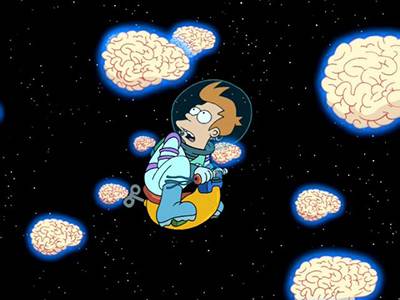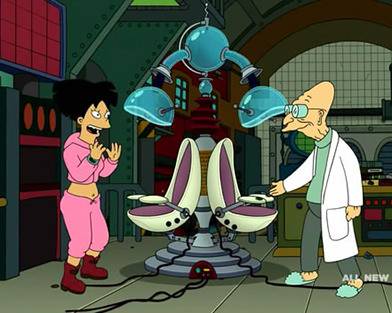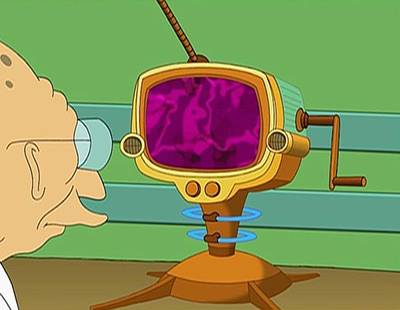
Futurama, the animated comedy from Simpsons creator Matt Groening and writer David X. Cohen, is unparalleled in its ability to mix lowbrow humor with high concept science and technology. But after an initial run on Fox from 1999 to 2003 and a glorious revival six years later, Comedy Central has pulled the plug and will end the show with its seventh season this summer.
In keeping with ReadWrite’s mission to map the programmable universe, we figured that a roundup of some of the greatest inventions from the year 3000 was most definitely called for. Futurama, after all, was always at its best turning some recent technological development or scientific notion into farce.
Did we miss any? Let us know in the comments.
Disclaimer: We decided to keep it light-hearted, so we apologize in advance to any fans of the infamous suicide booth.
1. Smell-O-Scope

In the show’s first season episode “A Big Piece Of Garbage,” the Smell-O-Scope was Professor Farnsworth’s seemingly useless space smelling invention. As he explained, “If a dog craps anywhere in the universe, you can bet I won’t be out of the loop.” It certainly came in handy when it detected a giant ball of garbage — a last-ditch effort by New York in the year 2020 to stave off overflowing landfills — that was hurling towards the Earth. The ensuing antics involved continuous spoofs on the 1998 film Armageddon.
Turns out that in 2011, a small company actually invented a handheld Smell-O-Scope, although it dubbed it the Nasal Ranger Field Olfactometer. Killjoys.
2. Scooty-Puff, Jr.

When Fry was tasked with saving the universe from the Brainspawn in season four, he had to infiltrate their secret base, the Infosphere. Fry’s allies against the brains, the highly intelligent yet adorable Niblonians, gave him the Scooty-Puff, Jr. for the task. A wind-up contraption resembling a children’s toy, the Scooty-Puff, Jr. ended up falling apart when Fry tried to escape, leading him to request a more advanced vehicle — the larger, more impressive Scooty-Puff, Sr.
3. Fing-Longer

Invented by Professor Farnsworth in an alternative timeline — one he detected via the What-If Machine in the season two episode “Anthology of Interest I,” the Fing-Longer allowed the wearer to reach farther than normal — say, to press buttons. Not exactly groundbreaking, but who couldn’t love a name like the Fing-Longer?
Not only does this device now actually exist as a Wii mote accessory, the idea of the Professor getting inspiration from himself provided an interesting philosophical conundrum. Can you be said to have invented something if the initial inspiration came from some external source, even if that external source is an alternate version of yourself? Yeah, we’ll get back to you on that.
4. Mind-Switcher

The season six episode “The Prisoner of Benda” introduced this invention of Professor Farnsworth and Amy, the Mind-Switcher. After a dizzying number of mind switches, the whole crew is in disarray with everyone in someone else’s body.
This episode generated what was apparently the first mathematical theorem created for a television show. Futurama writer Ken Keeler, who holds a doctorate in mathematics, wrote the Futurama Theorem as both a real-world theorem and the solution used in the show that proves “that regardless of how many mind switches between two bodies have been made, they can still all be restored to their original bodies using only two extra people, provided these two people have not had any mind switches prior.”
5. What-If Machine

The What-If Machine was a Professor Farnsworth device that could predict a scenario based on any “what if” question it was asked. After a series of events that pertain to each character on the crew and their respective “what if” questions, the Professor tosses the machine in the garbage, declaring it a failure due to the preposterous scenarios it generated. The whole episode turns on its head when everything is revealed to be one huge, layered simulation from the What-If Machine, generated when the Professor asks what if he had invented the Fing-Longer.
6. eyePhone

One of the few times Futurama took a swipe at real-world companies and products, the season six episode “Attack of the Killer App” introduced an obvious parody of a well-known Apple device. The writers envisioned a 31st Century eyePhone as an actual eye implant that projects a holographic screen in front of the user’s face.
7. Forwards Time Machine

Featured in one of the show’s best episodes, “The Late Philip J. Fry,” the Forwards Time Machine is a Professor Farnsworth invention that only lets you move through time in one direction, specifically to avoid temporal paradoxes (a topic the show has explored in past episodes). Fry joins Bender and the Professor to take the machine one minute into the future, though of course they screw up and get thrown thousands of years forward. Ultimately, they have nowhere to go except the end of time.
In true high-low concept fashion, Bender, Fry and the Professor couch it on lawn chairs, crack some beers and proceed to watch the universe end, only to realize that a new Big Bang begins to happen all over again. Turns out that idea is an actual scientific model, called the Big Bounce, that posits that the universe is forever oscillating through a cosmic boom-bust cycle.
8. The Electronium Hat

Invented by the Professor to give animals super intelligence, the Electronium Hat was a wearable device introduced in the season one episode “Mars University.” It used sunspots to produce “cognitive radiation,” whatever that means. The monkey Guenter gets uplifted by the hat and spends much of the episode quarrelling with Fry and lamenting the fact that he can’t live his natural life due to his unnatural super-smarts.
9. The Clone-O-Mat

In the season two episode “A Clone Of Mine Own,” the Professor introduces his own 12-year-old clone, named Cubert. Created via the Professor’s Clone-O-Mat, Cubert gets named as the Professor’s heir.
The Clone-O-Mat makes a return in the season four episode “Jurassic Bark,” one of the rare but emotionally powerful moments when Futurama shifted from comedy to animated drama. Nominated for an Emmy, the episode explores Fry’s anguish after discovering his former dog Seymour’s fossilized 21st century remains, a find that prompts Fry to agonize over whether or not to clone his long-lost animal companion.
10. The Spheroboom

Of all the Professor’s many doomsday devices, the Spheroboom was his favorite and the one device that he couldn’t part with when selling his stash to Hedonismbot in “Bender’s Big Score,” the straight-to-DVD film that became part one of season five. The Spheroboom appears to bend an object around its center until it implodes in an explosion of “doom radiation.”
In a not-so-subtle jab at the National Rifle Association, the episode introduced the National Ray-Gun Association, which protested a three-day waiting period for mad scientists to purchase doomsday devices.

















